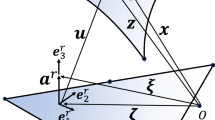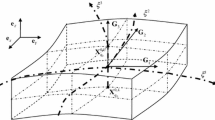Summary
A survey of effective finite element formulations for the analysis of shell structures is presented. First, the basic requirements for shell elements are discussed, in which it is emphasized that generality and reliability are most important items. A general displacement-based formulation is then briefly reviewed. This formulation is not effective, but it is used as a starting point for developing a general and effective approach using the mixed interpolation of the tensorial components. The formulation of various MITC elements (that is, elements based on Mixed Interpolation of Tensorial Components) are presented. Theoretical results (applicable to plate analysis) and various numerical results of analyses of plates and shells are summarized. These illustrate some current capabilities and the potential for further finite element developments.
Similar content being viewed by others
References
Noor, A.et al. (eds.) (1989), “Analytical and Computational Models of Shells”,ASME Special Publication. CED-3.
Bathe, K.J. and Dvorkin, E. (1986), “A Formulation of General Shell Elements—the Use of Mixed Interpolation of Tensorial Components”,International Journal for Numerical Methods in Engineering,22, pp. 697–722.
Love, A.E.H. (1888), “The Small Free Vibrations and Deformation of a Thin Elastic Shells”,Phil. Trans. Roy. Soc. London, (Ser. A) 179), pp. 491–546.
Koiter, W.T. (1959), “A Consistent First Approximation in General Theory of Thin Elastic Shells”, InProc. IUTAM Symposium on the Theory of Thin Elastic Shells. Delft, pp. 12–33.
Sanders, J.L. Jr. (1959), “An Improved First Approximation Theory for Thin Shells”,Tech. Report R-24, NASA.
Kardestuncer, H. (ed.) (1987), “Finite Element Handbook”, MacGraw-Hill.
Ahmad, S., Irons, B.M. and Zienkiewicz, O.C. (1970), “Analysis of Thick and Thin Shell Structures by Curved Finite Elements”,International Journal for Numerical Methods in Engineering,2, pp. 419–451.
Ramm. E. (1977), “A Plate/Shell Element for Large Deflections and Rotations”, In Bathe, K.J. (ed.),Formulations and Computational Algorithms in Finite Element Analysis, M.I.T. Press.
Bathe, K.J. and Bolourchi, S. (1979), “A Geometric and Material Nonlinear Plate and Shell Element”,Computers & Structures,11, 23–48.
Zienkiewicz, O.C., Taylor, R.L. and Too, J.M. (1971), “Reduced Integration Techniques in General Analysis of Plates and Shells”,International Journal for Numerical Methods in Engineering,3, pp. 275–290.
Oñate, E., Hinton, E. and Glover, N. (1978), “Techniques for Improving the Performance of the Ahmad Shell Elements”,Proc. Int. Conf. on Applied Numerical Modelling, Pentech Press, Madrid, pp. 30–53.
Hughes, T.J.R., Cohen, M. and Haroun, M. (1978), “Reduced and Selective Integration Techniques in the Finite Element Analysis of Plates”,Nuclear Engineering Design,46, pp. 203–222.
Malkus, D.S. and Hughes, T.J.R. (1978), “Mixed Finite Element Methods-Reduced and Selective Integration Techniques: A Unification of Concepts”,Computer Methods in Applied Mechanics and Engineering,15, pp. 63–81.
Bercovier, M. (1978), “Perturbation of a Mixed Variational Problems. Applications to Mixed Finite Element Methods”,R.A.I.R.O. Anal. Numer.,12, pp. 211–236.
Belytschko, T., Liu, W.K., Ong, S.J. and Lam, D. (1985), “Implementation and Application of a 9-node Lagrange Shell Element with Spurious Mode Control”,Computers & Structures,20, (1–3), pp. 121–128.
Belytschko, T., Ong, S.J. and Liu, W.K. (1985), “A Consistent Control of Spurious Singular Modes in the 9-Node Lagrangian Element for the Laplace and Mindlin Plate Equations”,Computer Methods in Applied Mechanics and Engineering,44, pp. 269–295.
Bathe, K.J. and Brezzi, F. (1985), “On the Convergence of a Four-Node Plate Bending Element Based on Mindlin/Reissner Plate Theory and a Mixed Interpolation”. In Whiteman, J.R. (ed.),Proceedings of the Conference on Mathematics of Finite Elements and Applications V, Academic Press, pp. 491–503.
Bathe, K.J. and Brezzi, F. (1987), “A Simplified Analysis of Two-Plate Bending Elements—the MITC4 and MITC9 Elements”, In Pande, G.N. and Middleton, J. (eds.),Proceedings of the International Conference on Numerical Methods in Engineering (NUMETA 87), University College of Swansca, Wales, p. D46.
Brezzi, F., Bathe, K.J. and Fortin, M. (1989), “Mixed-Interpolated Elements for Reissner-Mindlin Plates”,International Journal for Numerical Methods in Engineering,28, pp. 1787–1801.
Brezzi, F., Fortin, M. and Stenberg, R. (1991), “Error Analysis of Mixed-Interpolated Elements for Reissner-Mindlin Plates”,Mathematical Models and Methods in Applied Sciences,1, pp. 125–151.
Dvorkin, E. and Bathe, K.J. (1984), “A Continuum Mechanics Based Four-Node Shell Element for General Nonlinear Analysis”,Engineering Computations,1, pp. 77–88.
Bathe, K.J. and Dvorkin, E. (1985), “A Four-Node Plate Bending Element Based on Mindlin-Reissner Plate Theory and a Mixed Interpolation”,International Journal for Numerical Methods in Engineering,21, pp. 367–383.
Bathe, K.J., Cho, S.W., Bucalem, M.L. and Brezzi, F. (1989), “On Our MITC Plate Bending/Shell Elements”, In Noor, A.et al. (eds.),Analytical and Computational Models of Shells, CED-3, ASME Special Publication, pp. 261–278.
Bathe, K.J., Brezzi, F. and Cho, S.W. (1989), “The MITC7 and MITC9 Plate Bending Elements”,Computers & Structures,32, (3/4), pp. 797–814.
Bathe, K.J., Bucalem, M.L. and Brezzi, F. (1990), “Displacement and Stress Convergence of Our MITC Plate Bending Elements”,Engineering Computations,7, 4, pp. 291–302.
Pitkäranta, J. (1991), “The Problem of Membrane Locking in Finite Element Analysis of Cylindrical Shells”, Report, Helsinki University of Technology, Otakaari 1, SF-02150 Espoo, Finland.
Hughes, T.J.R. and Tezduyar, T.E. (1981), “Finite Elements Based upon Mindlin Plate Theory with Particular Reference to the Four-Node Bilinear Isoparametric Element”,Journal of Applied Mechanics, Transactions of ASME,48, pp. 587–596.
MacNeal, R.H. (1982), “Derivation of Element Stiffness Matrices by Assumed Strain Distributions”,Nuclear Engineering Design,70, pp. 3–12.
Bathe, K.J. (1996), “Finite Element Procedures”, Prentice Hall, Inc., Englewood Cliffs.
Schweizerhof, K. and Ramm, E. (1984), “Displacement Dependent Pressure Loads in Nonlinear Finite Element Analysis”,Computers & Structures,28, pp. 1099–1114.
Argyris, J. (1982), “An Excursion with Large Rotations”,Computer Methods in Applied Mechanics and Engineering,32, pp. 85–155.
Bathe, K.J. (1986), “Finite Elements in CAD and ADINA”,Journal of Nuclear Engineering and Design,98, pp. 57–67.
Bathe, K.J. and Ho, L. (1981), “Finite Elements in CAD and ADINA”,Nonlinear Finite Element Analysis in Structural Mechanics, Wunderlich, W.et al. (eds.), Springer Verlag, Berlin.
Hughes, T.J.R., Taylor, R.L. and Kanoknukulchai (1977), “A Simple and Efficient Finite Element for Plate Bending”,International Journal for Numerical Methods in Engineering,11, pp. 1529–1543.
Huang, H.C. and Hinton, E. (1986), “A New Nine-Node Degenerated Shell Element with Enhanced Membrane and Shear Interpolation”,International Journal for Numerical Methods in Engineering,22, pp. 73–92.
Park, K.C. and Stanley, G.M. (1986), “A curvedC o Shell Element Based on Assumed Natural-Coordinate Strains”,Journal of Applied Mechanics, Transactions of ASME, 53, pp. 278–290.
Jang, J. and Pinsky, P.M. (1987), “An Assumed Covariant Strain Based 9-Node Shell Element,”International Journal for Numerical Methods in Engineering,24, pp. 2389–2411.
Bucalem, M.L. and Bathe, K.J. (1993), “Higher-Order MITC General Shell Elements”,International Journal for Numerical Methods in Engineering,36, pp. 3729–3754.
Sussman, T. and Bathe, K.J. (1987), “A Finite Element Formulation for Nonlinear Incompressible Elastic and Inelastic Analysis”,Computers & Structures,26, pp. 357–409.
Häggblad, B. and Bathe, K.J. (1990), “Specifications of Boundary Conditions for Reissner-Mindlin Plate Bending Finite Elements”,International Journal for Numerical Methods in Engineering,30, pp. 981–1011.
Arnold, D.N. and Falk, R.S. (1989), “Edge Effects in Reissner-Mindlin Plate Theory”, In Noor, A.et al., (eds.)Analytical and Computational Models of Shells, CED-3, ASME Special Publication.
ADINA R&D (1990), “ADINA—A Finite Element Program for Automatic Dynamic Incremental Nonlinear Analysis”, Report 90-1, ADINA R&D, Watertown, MA.
Lindberg, G.M., Olson, M.D. and Cowper, E.R. (1969), “New Developments in the Finite Element Analysis of Shells”,National Research Council of Canada, Quarterly Bulletin of the Division of Mechanical Engineering and the National Aeronautical Establishment,4, pp. 1–38.
Sussman, T. and Bathe, K.J. (1986), “Studies of Finite Element Procedures. Stress Band Plots and the Evaluation of Finite Element Meshes”,Engineering Computations,3, pp. 178–191.
Morley, L.S.D. and Morris, A.J. (1978), “Conflict Between Finite Elements and Shell Theory”, Technical report, Royal Aicraft Establishment Report, London.
Bathe, K.J. and Dvorkin, E.N. (1983), “On the Automatic Solution of Nonlinear Finite Element Equations”,Computers & Structures,17, 5–6, pp. 871–879.
Leicester, R.H. (1968), “Finite Deformations of Shallow Shells”, InProceedings of American Society of Civil Engineers,94, (EM6), pp. 1409–1423.
Sabir, A.B. and Lock, A.C. (1973), “The Application of Finite Elements in the Large Deflection Geometrically Nonlinear Behavior of Cylindrical Shells”, In Brebbia, A. and Tottcham, H. (eds.),Variational Methods in Engineering, pp. 7/66–67/75, Southampton University Press.
Chapelle, D. and Bathe, K.J. (1993), “The Inf-Sup Test”,Computer and Structures,47, pp. 537–545.
Author information
Authors and Affiliations
Rights and permissions
About this article
Cite this article
Bucalem, M.L., Bathe, K.J. Finite element analysis of shell structures. ARCO 4, 3–61 (1997). https://doi.org/10.1007/BF02818930
Received:
Issue Date:
DOI: https://doi.org/10.1007/BF02818930




